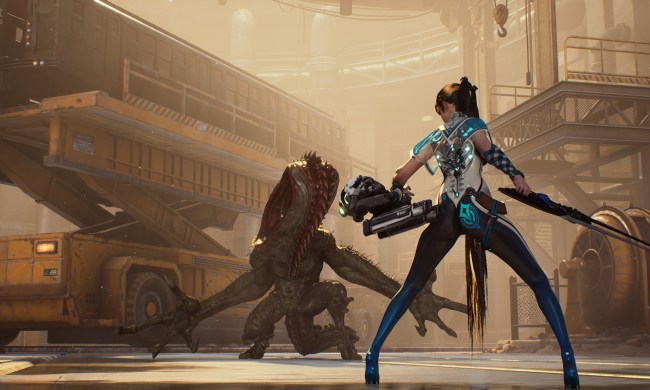Perhaps the greatest advancement in game development in recent years is the ease of access for the average person to start making a game. This has lowered the barrier of entry to the point where creators of almost any skill level can get their games on a major platform; however, the platforms themselves have not adapted to accommodate the overwhelming amount of content added each day. It’s reached the point where the most prominent digital storefronts — PlayStation, Xbox, and Steam — are so saturated with new games on a daily basis that even great games can get buried and lost forever.
Excluding AAA games with massive PR and marketing budgets, every other game looking to get a shred of attention at launch is playing a rigged game of roulette with its success. We’ve hit a critical mass with the number of games coming out where the cream no longer rises to the top based on quality alone. As we approach an all-digital (or at least primarily digital) future, storefronts need to solve this discoverability problem sooner rather than later. It isn’t an issue of there being too many games, but the fact that the right games aren’t able to reach their target audience.
15 minutes of fame
When Braid was first released in 2008, there were only a total of 242 releases on Steam for that entire year. Fast forward to 2024 — which still has a quarter of the year left — and there have already been 10,862 game releases. That’s an average of almost 50 games per day thus far. Because storefronts like the PSN and Xbox have remained largely unchanged in the intervening years, Braid: Anniversary Edition was released and almost immediately pushed off the new releases pages.
With its primary means of exposure to the masses who don’t follow major gaming news cut off, this re-release of an established critical and commercial hit “has sold like dogs**t” according to creator Jonathan Blow. While we don’t know specific numbers across all platforms, Blow did remark that Steam was its biggest platform. Even then, the game’s player count peaked at a mere 570.

Then there’s World of Goo 2, another IP with a strong legacy behind it, which just released at the beginning of August and yet seems to have made no splash at all. One can only imagine how intimidating it must be for a team preparing to launch a new IP seeing how volatile the landscape is. When a game is launching alongside 50 others, poor timing can be the difference between appearing at the top of the store for a few hours or a few minutes.
One doesn’t need to look back that far to find a prime example of that, either. You might recall a lot of attention online brought to Stumbling Cat’s Potions: A Curious Tale — for all the wrong reasons. Its launch became a viral moment that shined a light on how platforms like Steam aren’t the friendliest places for indie devs. Speaking with Digital Trends, Stumbling Cat CEO and Creative Director Renee Gittins recalled the event.
“Just hours after my release, EA rereleased 11 titles from their back catalog without prior warning,” Gittins tells Digital Trends. “This immediately pushed my title off of the New & Trending list, despite going into my launch with well over twice the amount of wishlists estimated for featuring. The initial result was that I only saw 34% of the sales I conservatively predicted on my launch day. While my later virality helped boost those sales numbers, seeing 66% less sales than I expected due to an undetectable factor outside of my control was absolutely devastating.”
The gravity of missing that initial week of exposure can have a major impact on developers. “As an indie developer, awakening Steam’s algorithms can be the difference between hundreds of dollars of sales and hundreds of thousands, and there is a narrow window in which it is possible,” Gittins says. “While some games can become popular long after release, the way Steam, games journalism, and player attention works pushes the highest significance to the first week of the game’s release and any efforts that help make that week as successful as possible.”
Of course, platforms don’t make understanding how these systems or algorithms for discovery work simple. Developer Josiah Peoples, who is currently working on a solo project called Shadow of Mammon, laments the fact that platforms like Steam are a total mystery.
“Platforms are mostly quiet about how discoverability works. The algorithm seems to change frequently,” Peoples explains. “For instance, do I need 7,000 or 10,000 Wishlist to be promoted on Steam?” Both Gittins and Peoples have suggested indie developers seek outside resources to better understand how to play the system, citing How to Market Your Game by Chris Zukowski and online resources like How To Market a Game.
Other developers offered a few suggestions on how these systems could be improved, but all admitted there was no clear solution without some drawbacks. Such examples included excluding re-releases from the New and Trending page, and offering filter tools to users on featured lists, but the main consensus was a desire for more opportunities on and off Steam for indie devs to showcase their games.
Like it or not, digital distribution is the primary way games are sold. That opens up so many doors for creators, but our current stores just aren’t built in such a way where great games can thrive like they used to. Our storefronts need to reward effort and quality and not reserve success for only games with the biggest marketing budgets. Gittins highlights the double-edged nature of storefronts in their current form.
“Large studios have marketing budgets of millions of dollars, easily land high exposure coverage from game outlets, and have their own fan communities that are happy to sing their praises,” Gittins says. “As an indie developer, you have few tools to get your game in front of potential customers. Steam is not just a game distribution platform, it is the best game marketing platform for developers … The advantage of Steam is that games are treated equally; That everyone has a shot at getting coverage if they do the footwork to set up their success.”
For every Balatro that manages to find that vocal audience to give it a strong signal boost, hundreds are not so lucky. In a perfect world, an indie and AAA game being viewed on equal terms by storefronts would be ideal, but that isn’t the full picture. Indies have an uphill battle against the marketing power of a big studio and need more discoverability tools to find that target audience who will sing its praises.




